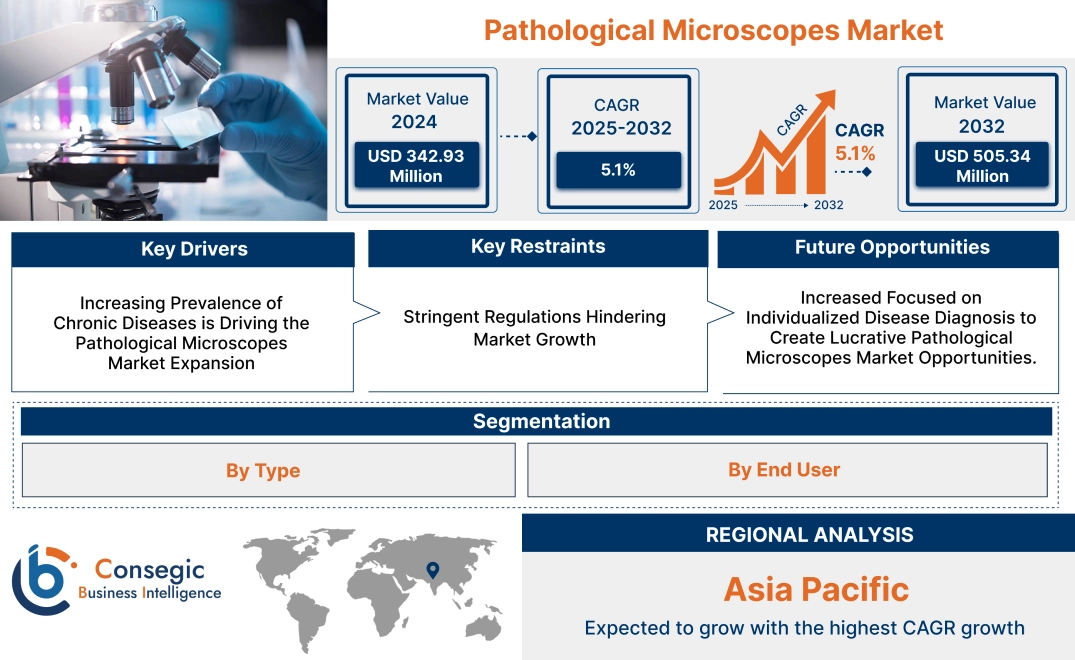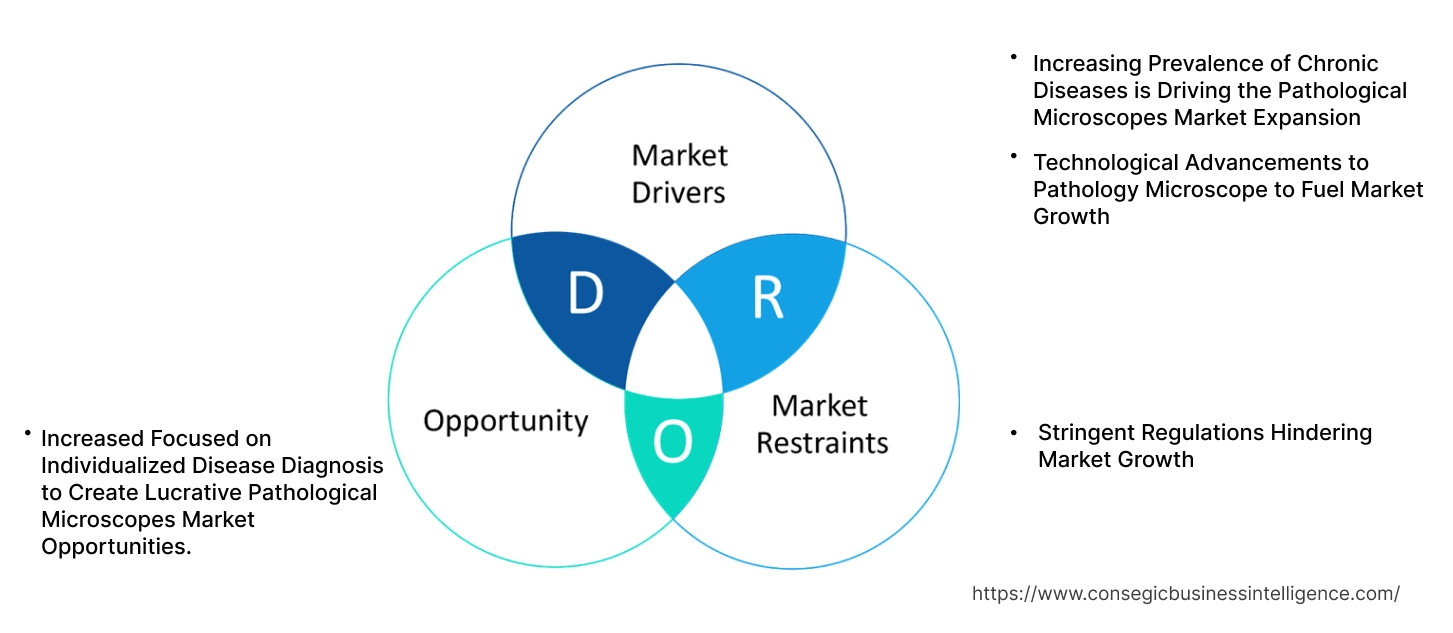Pathological Microscopes Market Size:
Pathological Microscopes Market size is growing with a CAGR of 5.1% during the forecast period (2025-2032), and the market is projected to be valued at USD 505.34 Million by 2032 from USD 342.93 Million in 2024.
Pathological Microscopes Market Scope & Overview:
Pathological microscopes are essential tools in healthcare that aid in the examination of biological samples like tissues, blood, and cells. These advanced instruments feature high-resolution optics, and a range of magnification options amongst other features. This combination allows for detailed analysis, vital for accurate disease diagnosis and research. Hospitals, diagnostic labs, and research institutions widely utilize pathology microscopes for tasks like histopathology, cytology, and microbiology. Due to the increasing requirement for precise diagnostics, these microscopes play a vital role in early disease detection and informed treatment decisions. The global pathology microscope market is driven by several factors, including the growing prevalence of chronic diseases, advancements in medical technology amongst others. Leading microscope manufacturers like Olympus, Leica Microsystems, Nikon, and Zeiss are key players in this market.
How is AI Impacting the Pathological Microscopes Market?
AI is transforming the pathological microscopes market by automating processes, increasing speed and accuracy in diagnosis, and improving workflow efficiency through digital pathology. AI algorithms analyze vast image datasets to detect disease patterns, aid in diagnostic decision-making, and prioritize urgent cases, which leads to better patient outcomes. This integration is creating a demand for advanced AI-powered microscopes, streamlining the path to precision medicine, and enhancing diagnostic consistency and accessibility across healthcare settings.
Pathological Microscopes Market Dynamics - (DRO) :
Key Drivers:
Increasing Prevalence of Chronic Diseases is Driving the Pathological Microscopes Market Expansion
The increasing prevalence of chronic diseases is a significant driver pathological microscopes market growth. Chronic diseases, such as cardiovascular diseases, cancer, diabetes, and respiratory diseases, are on the rise globally due to factors like aging populations, lifestyle changes, and environmental factors. These diseases often involve long-term inflammation and require ongoing medical management.
Accurate and timely diagnosis of chronic diseases is crucial for effective treatment and management. Pathological microscopes play a critical role in this process by enabling the examination of tissue samples, blood smears, and other biological specimens to identify the underlying causes of these diseases. For example, in cancer diagnosis, microscopes are used to examine tissue biopsies to determine the type, stage, and grade of the tumor, which guides treatment decisions.
- For Instance, according to the analysis provided by the World Health Organization in 2022, cancer is a leading cause of death worldwide, accounting for nearly 10 million deaths in 2020, or nearly one in six deaths. The most common cancers are breast, lung, colon, rectum, and prostate cancers. Cancer-causing infections, such as human papillomavirus (HPV) and hepatitis, are responsible for approximately 30% of cancer cases in low- and lower-middle-income countries.
The increasing complexity of chronic diseases necessitates more precise diagnostic tools. Therefore, as the prevalence of chronic diseases continues to grow, the requirement for high-quality microscopes is expected to increase significantly, thus driving the pathological microscopes market demand.
Technological Advancements to Pathology Microscope to Fuel Market Growth
Technological advancements in pathology microscopes are significantly fueling market development. The integration of advanced technologies like eye tracking, augmented reality, and stage tracking transforms traditional microscopes into powerful data-generating tools.
By tracking the operator's gaze, eye-tracking technology provides insights into their focus areas and decision-making processes during microscopic examination. This data is then used to optimize workflows, identify areas for improvement in training, and even develop AI-powered diagnostic tools. Augmented reality overlays digital information, such as annotations and 3D models, onto the microscope's field of view, enhancing the visualization and interpretation of complex samples.
Additionally, stage tracking records the movement of the microscope stage, providing precise information about the areas examined by the pathologist. This data is used to reconstruct the examination process, facilitate collaborative analysis, and improve the reproducibility of research findings.
For Instance,
- In 2022, Augmentiqs and SeeTrue Technologies have collaborated to enhance pathology research and streamline workflows. By integrating advanced eye tracking, augmented reality, and stage tracking capabilities into existing light microscopes, they provide researchers and clinicians with a powerful toolset including microscopes for pathology. This innovative solution enables the collection of rich, previously inaccessible data, ultimately leading to improved diagnostic accuracy, more efficient research, and advancements in patient care.
Owing to the aforementioned factors, the market for pathological microscopes is experiencing development.
Key Restraints:
Stringent Regulations Hindering Market Growth
Stringent regulations, such as those outlined in FDA Section 864.3600, pose significant hurdles to the development of the market. While these regulations aim to ensure the safety and effectiveness of medical devices, they also create hurdles for manufacturers and innovators. Adhering to regulatory requirements, including those related to design, manufacturing, and performance, is a complex and time-consuming process.
For Instance,
- According to FDA Section 864.3600, microscopes and their accessories as optical instruments used for enlarging images in medical applications. It specifically exempts most types of microscopes, including fluorescence microscopes, from the premarket notification procedures required for many medical devices. Furthermore, if these devices are not labeled or represented as sterile, they are generally exempt from most of the current Good Manufacturing Practice (cGMP) requirements, except for record-keeping and complaint handling regulations.
Manufacturers need to invest substantial resources in research and development, quality control systems, and regulatory submissions to obtain these necessary approvals. This significantly increases the time-to-market for new products, hindering innovation and delaying the availability of advanced microscope technologies to end-users. Furthermore, the financial implications of regulatory compliance are significant. The costs associated with meeting regulatory requirements, including personnel, testing, documentation, amongst others are significant, particularly for smaller companies with limited resources. These costs impact a company's profitability and hinder its ability to invest in research and development of new and innovative products.
In conclusion, while stringent regulations are essential to ensure the safety and effectiveness of medical devices, they also present significant hurdles for the market.
Future Opportunities :
Increased Focused on Individualized Disease Diagnosis to Create Lucrative Pathological Microscopes Market Opportunities.
The growing focus on individualized disease diagnosis presents a significant pathological microscopes market opportunities. It is focused on due to the increasing demand for personalized medicine approaches, which aim to tailor diagnosis for specific diseases such as renal disease, amongst others.
The need to accurately diagnose and characterize rare or complex diseases at the cellular level is valuable in the context of personalized medicine. For example, in the case of renal diseases, electron microscopy can help identify specific genetic mutations or immune-mediated processes that contribute to disease progression in individual patients. This information is then used to guide treatment decisions, such as selecting targeted therapies or adjusting medication dosages based on individual patient characteristics.
For Instance,
- In 2024, NSW Health Pathology's Concord laboratory announced the acquisition of a new electron microscope, which will significantly improve the diagnosis of renal diseases.
Hence, as the field of personalized medicine continues to evolve, the demand for pathological microscopes for specific diseases is expected to create lucrative prospects.
Pathological Microscopes Market Segmental Analysis :
By Type:
Based on type, the market is categorized into electron microscope, optical microscope, compound microscope, digital microscope, fluorescence microscope, and others.
Trends in the Type:
- Digital microscopes offer enhanced image capture, storage, and sharing capabilities, facilitating remote consultations and improving diagnostic efficiency.
- Advanced optical microscopes such as fluorescence microscopes are gaining traction
The Electron Microscope segment accounted for the largest market share in 2024.
- Electron microscopy (EM) is dominating the pathology microscope market due to its ability to provide high-resolution images of biological samples.
- Unlike light microscopy, which is limited by the wavelength of light, EM utilizes a beam of electrons to generate images, allowing for significantly higher magnification and resolution.
- This capability is crucial for visualizing intricate cellular structures, organelles, and macromolecular complexes that are beyond the reach of traditional light microscopy.
- The high resolution of EM images provides insights into the fine details of cellular pathology. This is essential for diagnosing a wide range of diseases, including kidney diseases, muscle disorders, neurological disorders, and various viral infections.
- For Instance, in 2021, Thermo Fisher Scientific introduced the Helios 5 PXL Wafer DualBeam microscope, a cutting-edge PFIB SEM that significantly accelerates in-line metrology for high-aspect-ratio structures in pathology, reducing data acquisition time from days to hours.
- In conclusion, the unique feature of EM to provide high-resolution images of cellular structures and visualize complex pathological features makes it a vital product in modern pathology, thus driving the segment trends.
The Digital Microscope segment is expected to grow at the fastest CAGR over the forecast period.
- Digital microscopy is experiencing the fastest CAGR within the pathology microscope market due to a several factors. One key factor is the significant advancements in digital imaging technologies, enabling the capture of high-resolution images with exceptional clarity and detail.
- These advancements, coupled with the increasing computational power available, facilitate the acquisition and processing of large volumes of image data with speed and accuracy.
- Furthermore, the integration of software with digital microscopy systems has enhanced the way pathologists analyze and interpret data. These software platforms offer a wide range of powerful tools for image analysis, including image enhancement, segmentation, 3D reconstruction, and quantitative measurements.
- The growing emphasis on telepathology and remote consultations is another major factor creating lucrative prospects towards higher adoption of digital microscopes.
- In conclusion, the combination of above-mentioned advancements is creating trends for digital microscopes within the market.
By End User:
The end user segment is categorized into forensic laboratories, hospitals and clinics, and diagnostic laboratories
Trends in the End User:
- Adoption of techniques like fluorescence microscopy and confocal microscopy for improved diagnostic accuracy.
- Increased demand for accurate and timely diagnoses of conditions like cancer and cardiovascular diseases.
The hospitals and clinics segment accounted for the largest market share of 52.11% in 2024.
- Hospitals and clinics are the dominant end-users in the pathology microscope market due to their critical role in patient care. Accurate and timely diagnoses are mandatory in healthcare, and pathology laboratories within these institutions play a vital role by examining tissue samples, blood smears, and other biological specimens to identify diseases.
- The high volume of patient samples processed daily necessitates a robust infrastructure of pathology laboratories equipped with numerous high-quality microscopes.
- Furthermore, advancements in medical science, such as the rise of personalized medicine, demand more advanced diagnostic tools. These advancements require hospitals and clinics to invest in cutting-edge microscopy technologies, including digital microscopy and advanced imaging techniques, to ensure accurate diagnoses and guide personalized treatment plans.
- For Instance, Barts Health NHS Trust, one of the largest in England, operates five hospitals across London and conducts 26 million tests annually including a majority of pathology tests.
- Finally, many hospitals and clinics are actively involved in medical research. Microscopes are essential tools for conducting research on disease mechanisms, developing new therapies, and advancing medical knowledge, thus, driving the trends of the segment.
The diagnostic laboratories segment is expected to grow at the fastest CAGR over the forecast period.
- Diagnostic laboratories use pathology microscopes to identify abnormalities in bodily fluids such as blood, lymph, etc. amongst others.
- Additionally, the increasing incidence of chronic diseases like cancer, cardiovascular diseases, and diabetes necessitates accurate and timely diagnosis. These microscopes play a crucial role in examining tissue samples for abnormalities, aiding in the early detection and treatment of these diseases.
- Moreover, modern pathology microscopes are equipped with advanced features like high-resolution imaging, digital pathology capabilities, and image analysis software. These advancements enhance diagnostic accuracy, improve workflow efficiency, and enable better collaboration among pathologists.
- Furthermore, personalized medicine approaches require a deeper understanding of individual patient characteristics and disease biology. Pathology macroscopes contribute to this by enabling detailed examination of tissue samples, providing valuable insights into disease progression and treatment response.
- Overall, due to the aforementioned factors, diagnostic laboratories are expected to create lucrative opportunities in advancing health care, enabling earlier diagnosis and better patient outcomes, thus driving the segment trends.
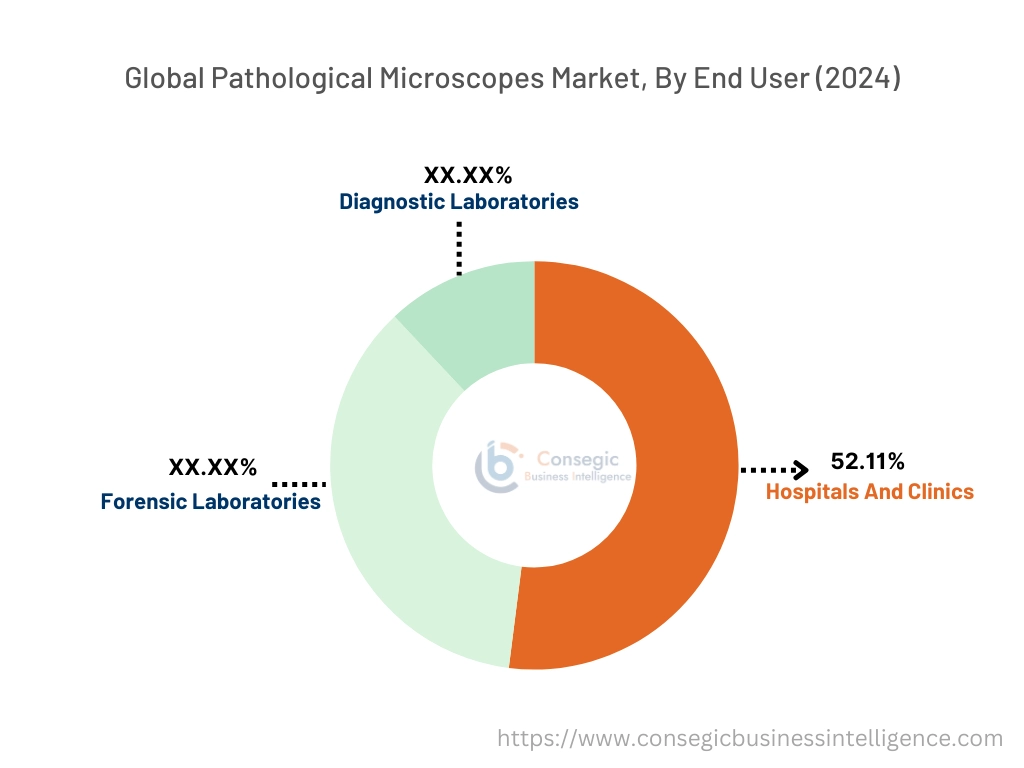
Regional Analysis:
The regional segment includes North America, Europe, Asia Pacific, the Middle East and Africa, and Latin America.
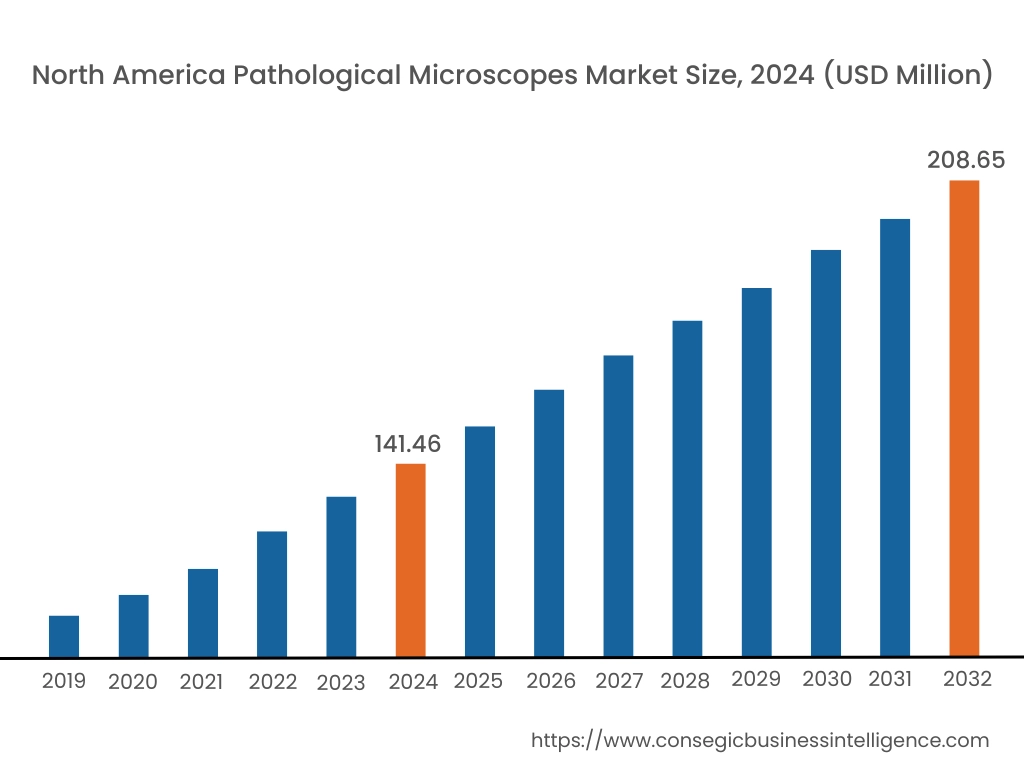
In 2024, North America accounted for the highest pathological microscopes market share at 41.25% and was valued at USD 141.46 Million and is expected to reach USD 208.65 Million in 2032. In North America, U.S. accounted for the pathological microscopes market share of 75.30% during the base year of 2024.
North America dominates the pathology microscope market. This dominance is attributed to several factors. The region has a well-developed healthcare system with significant investments in cutting-edge technologies and research, facilitating the adoption and integration of advanced pathology microscopes. Furthermore, the high prevalence of chronic diseases in North America necessitates the use of diagnostic tools, driving the pathological microscopes market demand. Finally, based on the pathological microscopes market analysis, the strong presence of strong presence of key market players in North America, added with high healthcare expenditure and a focus on medical research and development, further enhances the region's dominance in the market.
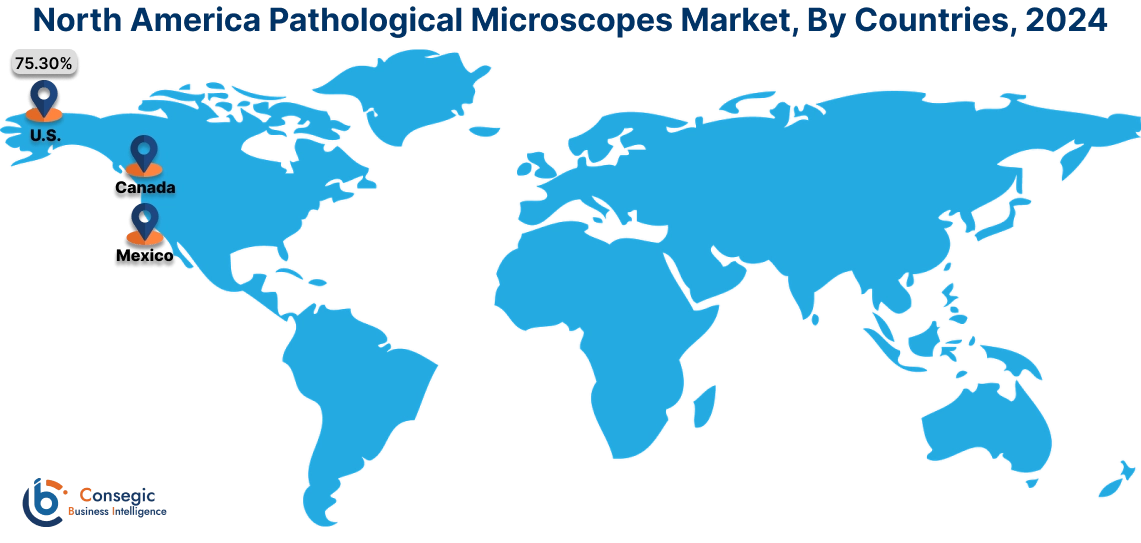
In Asia Pacific, the pathological microscopes industry is experiencing the fastest growth with a CAGR of 5.7% over the forecast period.
The Asia Pacific region is experiencing the fastest growth in the global pathology microscope market. This rapid expansion is driven by several key factors. These factors include many countries in the Asia Pacific region experiencing significant economic development, leading to increased healthcare spending and investments in advanced medical infrastructure. Additionally, the region is witnessing a surge in chronic diseases such as cancer, diabetes, and cardiovascular diseases. This necessitates improved diagnostic capabilities, driving the requirement for pathology microscopes.
- In 2024, Nikon Corporation announced the development and launch of the digital imaging microscope “ECLIPSE Ui” as the first-ever microscope for medical use in Japan. It is distributed via Nikon’s subsidiary Nikon Solutions Co., Ltd. The ECLIPSE Ui has a unique design without an eyepiece lens (even though is a microscope), a design which improves the pathologist’s observation posture and enables the sharing of observation images on the display. It contributes to reducing the physical burden on pathologists and improves the workflow of pathological observation.
Furthermore, based on the pathological microscopes market analysis, rising awareness among healthcare professionals and the public regarding the importance of early disease detection is driving the adoption of advanced diagnostic tools like pathology microscopes.
Europe holds a considerate share of the global market. This dominance is due to the well-developed healthcare infrastructure with a strong emphasis on research and development within the medical field, and a high prevalence of chronic diseases within the population. The region also has a significant presence of key market players in pathology microscope manufacturing, fostering innovation and competition. Additionally, a robust regulatory framework supports the adoption of advanced medical technologies, ensuring patient safety and efficacy. Furthermore, increasing government initiatives aimed at improving healthcare access and quality are driving market development by facilitating the acquisition and utilization of advanced diagnostic tools like pathology microscopes. Thus, the aforementioned factors are influencing the pathological microscopes market trends.
The Middle East and Africa present a diverse market for pathological microscopes, characterized by varying levels of development across different countries. While the region faces significant hurdles referring to the limited healthcare infrastructure in several industry areas, economic disparities, as well as inadequate access to healthcare for a substantial portion of the population, there are several key factors driving market development, particularly in countries with developing economies. These factors include increasing government investments in healthcare infrastructure development, growing awareness of advanced diagnostic technologies like pathology microscopes in hospitals and clinics, growing adoption rate of these microscopes among healthcare professionals, and the rising prevalence of infectious diseases are promoting pathological microscopes market growth.
Latin America presents an emerging market for pathology microscopes with moderate growth potential. Several factors are driving this pathological microscope market expansion. The increasing healthcare spending across the region is enabling greater investment in advanced medical technologies, including pathology microscopes. Additionally, growing awareness among healthcare professionals and the public about the importance of early disease detection is fostering a greater requirement for accurate diagnostic tools. This is further fueled by the rising prevalence of chronic diseases such as cancer, diabetes, and cardiovascular diseases, necessitating improved diagnostic capabilities, thus influencing the pathological microscopes market trends. However, significant hurdles hinder market development. Limited healthcare infrastructure in certain regions, particularly in rural areas, poses a significant barrier to the adoption and effective utilization of pathology microscopes. Moreover, uneven distribution of healthcare resources across the region results in limited access to quality diagnostic services, particularly in underserved communities.
Top Key Players and Market Share Insights:
The global Pathological Microscopes Market is highly competitive with major players providing products to the national and international markets. Key players are adopting several strategies in research and development (R&D) and product innovation to hold a strong position in the global pathological microscopes market. Key players in the pathological microscopes industry include-
- Nikon Corporation (Japan)
- Leica Biosystems Nussloch GmbH (Germany)
- Hitachi High-Technologies Corporation (Japan)
- Bruker Corporation (U.S.)
- Euromex Microscopen BV (Netherlands)
- Olympus Corporation (Japan)
- ZEISS International (Germany)
- Sakura Finetek USA (U.S.)
- Celestron LLC (U.S.)
- Labomed (U.S.)
Recent Industry Developments :
Product Launches:
- In 2023, Nikon Corporation announced the development and launch of the digital imaging microscope “ECLIPSE Ui” as the first-ever microscope for medical use in Japan. It is distributed via Nikon’s subsidiary Nikon Solutions Co., Ltd. The ECLIPSE Ui has a unique design without an eyepiece lens (even though is a microscope), a design which improves the pathologist’s observation posture and enables the sharing of observation images on the display. It contributes to reducing the physical burden on pathologists and improves the workflow of pathological observation.
Pathological Microscopes Market Report Insights :
| Report Attributes | Report Details |
| Study Timeline | 2019-2032 |
| Market Size in 2032 | USD 505.34 Million |
| CAGR (2025-2032) | 5.1% |
| By Type |
|
| By End User |
|
| By Region |
|
| Key Players |
|
| North America | U.S. Canada Mexico |
| Europe | U.K. Germany France Spain Italy Russia Benelux Rest of Europe |
| APAC | China South Korea Japan India Australia ASEAN Rest of Asia-Pacific |
| Middle East and Africa | GCC Turkey South Africa Rest of MEA |
| LATAM | Brazil Argentina Chile Rest of LATAM |
| Report Coverage |
|
Key Questions Answered in the Report
How big is the Pathological Microscopes Market? +
In 2024, the Pathological Microscopes Market is USD 342.93 Million.
Which is the fastest-growing region in the Pathological Microscopes Market? +
Asia Pacific is the fastest-growing region in the Pathological Microscopes Market.
What specific segmentation details are covered in the Pathological Microscopes Market? +
Type and End-User segmentation details are covered in the Pathological Microscopes Market
Who are the major players in the Pathological Microscopes Market? +
Nikon Corporation (Japan), Leica Biosystems Nussloch GmbH (Germany), Olympus Corporation (Japan), ZEISS International (Germany), Sakura Finetek USA (U.S.), Celestron LLC (U.S.), Labomed (U.S.), Hitachi High-Technologies Corporation (Japan), Bruker Corporation (U.S.), and Euromex Microscopen BV (Netherlands)
